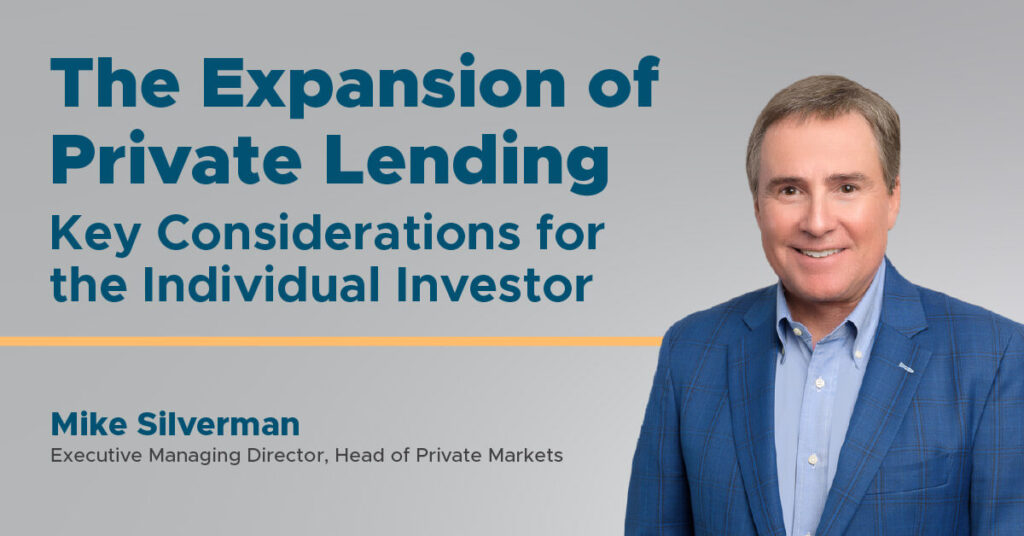
By Mike Silverman, Executive Managing Director
The private lending industry expanded in size from approximately $375 billion in capital under management in 2008 to $1.6 trillion in AUM by 2023[1]. This expansion can be linked to two major contributing factors: First, following the global financial crisis of 2008, regulators around the world imposed new requirements on banks. Those requirements for higher levels of capital and increased process around loan approvals and retention levels pushed many financial professionals to open non-depositor-funded lending operations. Second, investors who provided capital to these firms experienced attractive steady yields in a yield-starved environment (2008-2015, and again during COVID.) When rates began to rise after the pandemic eased, individual investors found the steady returns from lending money an attractive option to the price volatility of the public equity markets.
Today, private lending investment vehicles exist in multiple formats and with different underlying types of loans: corporate loans, consumer loans, asset-backed loans and real estate loans, to name a few. This article focuses on corporate loans in several formats and discusses the evergreen structure, the business development corporation (BDC), and drawdown private equity-style structures.
It’s worth noting that in all of these structures the income derived is mostly ordinary income and therefore taxed at ordinary rates. Investors might find that using a tax-exempt vehicle like an IRA is a more efficient execution.
A further consideration is the use of leverage by the fund manager to increase potential returns to the investor. Applying leverage works well as long as the underlying loans don’t experience distress or the lender isn’t faced with redemptions from their equity investors that force an unplanned sale of loans to generate funds to pay investors.
Evergreen Funds
Evergreen fund structures follow two basic formats: interval funds and tender offer funds. These funds offer many advantages, including giving investors immediate access to the asset class, which provides quarterly income. In other words, investors don’t have to wait for capital to be drawn and deployed. In addition, fee structures tend to be reasonable, opening accounts is easier than with private funds, tax reporting is done via Form 1099 (not K-1), and the net asset value (NAV) tends to remain in a narrow channel and is not impacted by daily mark-to-market forces.
Another important consideration for investors is the advertised liquidity. While evergreen structures offer liquidity features, those features can be “turned off” by the fund manager in situations where the underlying assets are not performing as expected or when assets can’t be financed or sold. So, investors should approach the advertised liquidity with caution if they need funds on short notice.
BDCs
BDCs operate similarly to evergreen structures in that they provide immediate exposure to the loan asset class. BDCs trade on stock exchanges, which allows the investor immediate exposure to the underlying loan portfolio. BDCs typically pay quarterly dividends (although these are generally ordinary income) and have reasonable fee structures.
There are two significant differences between BDCs and evergreen structures. Because they trade on an exchange, the share price of a BDC moves up and down just as a stock price moves. And because they trade on an exchange, investors can receive immediate liquidity if they need it. Investors should be aware that the ups and downs of the stock price may not reflect the underlying value of the loans and may be more reflective of technical factors affecting markets.
Drawdown Funds
Drawdown funds were the first structure to gain acceptance in the private lending sector. These funds are structured like private equity funds, with the fund manager only drawing capital as loans are needed. These structures can require several years to reach full deployment, but that means they have the advantage of creating exposure over multiple years, sheltering an investor from being fully exposed to credit conditions at any one moment. However, they are disadvantaged in that the investor does not earn an immediate return on their capital commitment. The fee structures of drawdown funds are similar to BDCs and interval funds, and they generally operate as limited partnerships, which means tax reporting is done via Form K-1.
Evaluating Private Lenders
As you can see, private lending is complicated and requires a thorough underwriting by investors and their advisors. It’s important that individual investors and their advisors are mindful of the following considerations:
- Does the fund manager have an adequate team to source lending opportunities?
- Does the manager have a large enough team to be the expert in the areas they lend money? Unlike private equity, a lender can only earn the loan coupon, and when loans go bad (which they will), returns can suffer.
- As an investor, do you want to pursue riskier, higher-return strategies, or safer but lower return strategies? Our experience suggests that over time the safer strategies will have better performance.
- Does the manager have the ability to manage the fund’s own balance sheet? A private lender raises both debt and equity capital to fund its activities and needs dedicated staff to perform those functions.
- Does the private lender have a team that can manage problem loans and take control of a company if needed? This is very important in an asset category where losses can quickly impact expected returns.
Contact us to learn more about private lending.
[1] https://www.brookings.edu/articles/what-is-private-credit-does-it-pose-financial-stability-risks/
About Cresset
Cresset is an independent, award-winning multi-family office and private investment firm with more than $235 billion in assets under management and advisement (as of 10/31/2025). Cresset serves the unique needs of entrepreneurs, CEO founders, wealth creators, executives, and partners, as well as high-net-worth and multi-generational families. Our goal is to deliver a new paradigm for wealth management, giving you time to pursue what matters to you most.
https://cressetcapital.com/disclosures/
